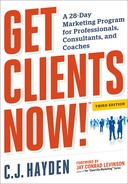WHAT GOES INTO A STRATEGY?
Think of marketing strategies as the highest-level organizing principle for your marketing and sales activities. When you are trying to decide if you should spend more effort on networking or publicity, for example, remember that networking is ranked as more effective. If you are wondering whether to plunk down a large sum of money for an ad special, ask first what that money would buy if you spent it on promoting yourself as a public speaker, since speaking has a higher rank than advertising.
Every strategy is made up of one or more tactics, or to put it another way, you use specific tactics to execute a chosen strategy. After the definition of each strategy in the sections below is a list of tactics you might use to employ it. And Part III of this book contains detailed marketing recipes that will tell you much more about how to use these tactics.
The following descriptions of marketing strategies will help you begin to consider what activities you will include in your Get Clients Now! program. Don’t worry about selecting specific tactics at this point. Focus on the overall strategies and think about which ones might work best for you.
One important note before you begin to read about marketing tactics: you are not going to use all of these tactics in the next twenty-eight days! You are not even going to use all the tactics listed for each strategy that you choose to adopt. The first secret of successful professional services marketing is to choose a set of simple, effective things to do, and do them consistently. You will be using only a few of these tactics at any one time. So don’t allow the list of possibilities to overwhelm you, just let it inform you.

STRATEGY: DIRECT CONTACT AND FOLLOW-UP
Direct contact means making person-to-person contact with a prospective client, in person, or by phone, mail, fax, e-mail, text message, or online. To get results, your first contact must be truly personal, not a form letter, bulk e-mail, or generic social media post. If you make contact in writing, address your communication to a specific person and mention some issue you know he or she is facing, or a connection you both share. If you don’t do this, you are merely generating advertising, whether you send a letter in the mail or post it on a social media platform.
After your initial contact, more impersonal direct communication, like postcards, e-zines, or broadcast e-mail can become effective follow-up techniques. But for interested prospects, use one-to-many approaches like these as a supplement to personal contact, not a substitute for it.
Note that the marketing strategy of direct contact and follow-up refers here to contact with a prospective client. It does not refer to the contact and follow-up activities you may do with colleagues and others while you are using the strategy of networking and referral building.
